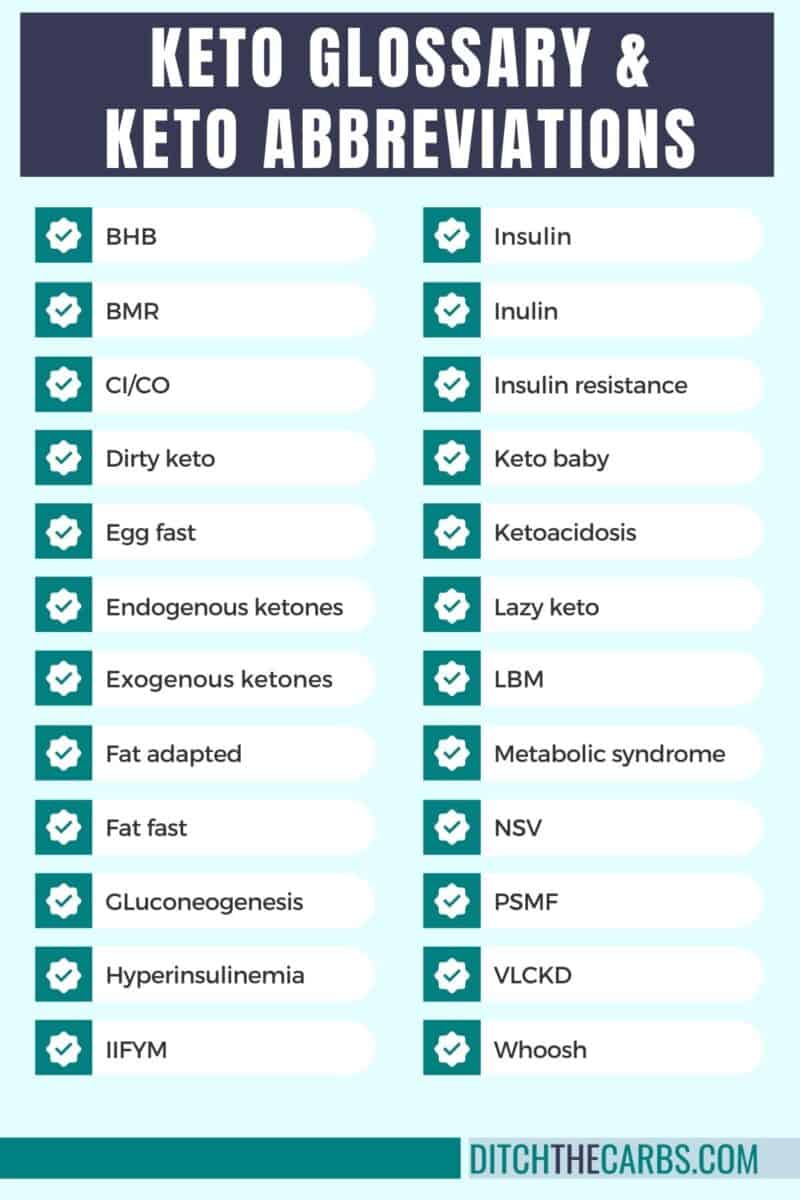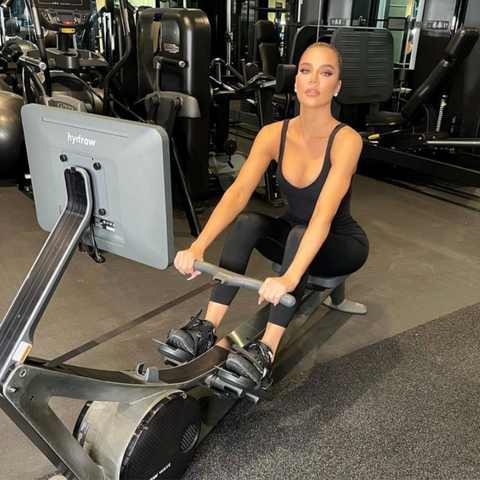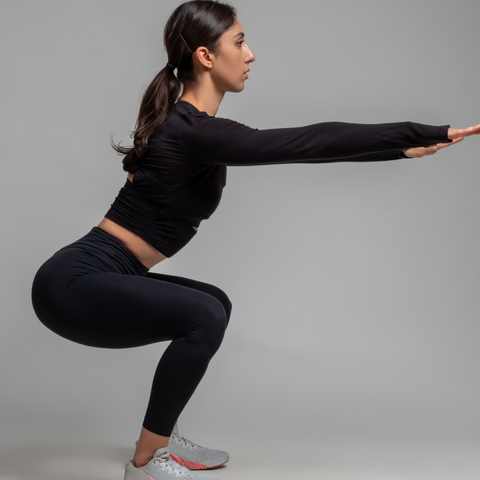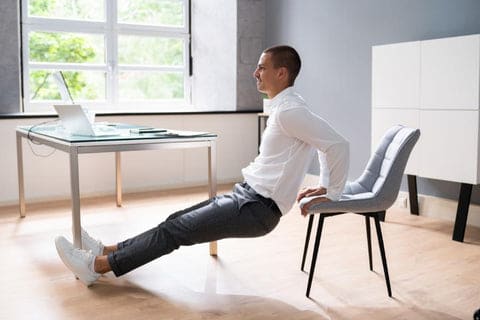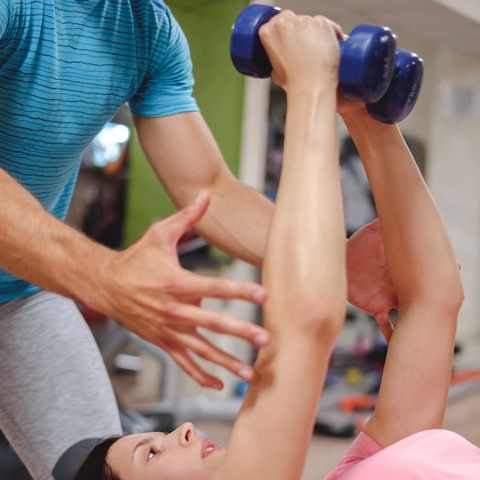And while many lifters may view the elliptical as an activity best reserved for cardio bunnies, this versatile piece of exercise equipment is also great for muscle activation. In fact, research shows that in addition to being easy on your joints, the elliptical can also be used to help build muscle1.
Which muscles does it help build, you ask?
You’ve come to the right place to find out, as we’re about to discuss this in detail. After reading this, we’re certain you’ll agree that whether you’re a weight lifter or an endurance trainee, the elliptical deserves a spot in your workout routine.
Table of Contents:
- What Is An Elliptical Machine?
- What Muscles Do The Elliptical Work?
- Does An Elliptical Build Muscle & Assist With Weight Loss?
- Proper Elliptical Machine Form
- Elliptical Benefits
- Programming The Elliptical
- Best Muscle-Building Elliptical Workout
- Best Weight Loss HIIT Workout
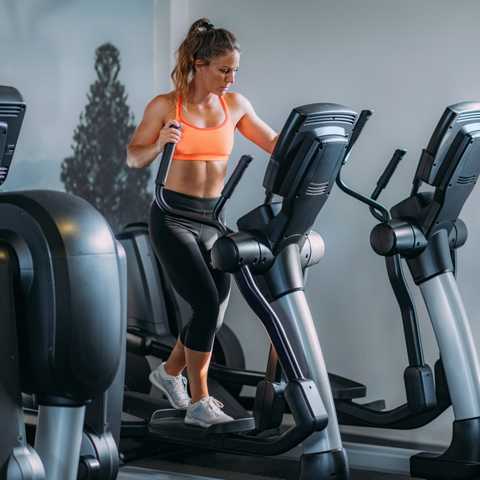
What is an Elliptical Machine?
Combining the best of an exercise bike, stair climber, and treadmill, the elliptical enables you to simultaneously activate both the upper and lower body as you work the handles in a push-and-pull motion.
There are many variations of ellipticals, with the programs, peddles, handles, and motions varying with each; however, almost all of them will have an easy-to-use quick start option and the ability to increase resistance and raise the incline. Ellipticals are one of few cardio machines that simultaneously provide your body with low-impact and weight-bearing benefits.
At first glance, this low-impact workout may not seem like a way to work your muscles but trust us, if you’re putting serious effort into the push-pull mechanism, your muscles will be highly activated.
Wondering which ones are working? Let’s find out.
Elliptical Muscles Worked
When discussing elliptical machine muscles worked, the elliptical is particularly effective because it mimics your natural gait. It uses its handles and pedals to increase your inter-limb coordination, similar to walking or running. Each push and pull of the machine ensures it’s a full body workout.
Here is what is hard at work.
Lower Body Muscles
Every lower body muscle, including your glutes, hamstrings, quads, and calves, are hard at work during a workout on an elliptical cardio machine.
Glutes:
The gluteus maximus, medius, and minimus, also known as your butt muscles, sit behind the pelvis. Each time your pedal moves backward, the glutes concentrically contract, stabilizing your pelvis. The glute’s primary movement is hip extension, a movement exhibited in exercises such as glute bridges.
The higher your incline, the more you will target the glutes, similar to walking up a hill. Whether your goal is to perform butt lifting exercises or simply strengthen these powerhouse muscles, the elliptical will help get you there.
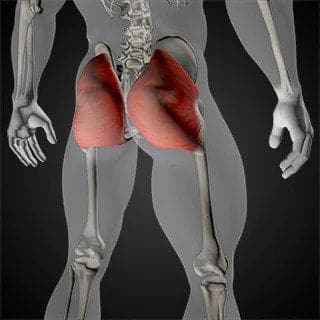
Hamstrings:
We can’t answer the question “what muscles do ellipticals work” without discussing the hamstrings! The hamstrings are a group of three muscles located on the back of your thigh and include the biceps femoris, semitendinosus, and semimembranosus.
These muscles work each time you push the elliptical pedal down, assisting the glutes with hip extension. They also act as a synergist to the quads as you push the pedal forward into knee flexion.
The hamstrings will work even harder if you increase the incline or reverse the elliptical motion and begin moving backward. Strengthening the posterior chain muscles (glutes, lower back, hamstrings) not only helps counteract all the sitting most of us do during the day, but it also transfers to improving major strength training exercises, like squats and deadlifts.
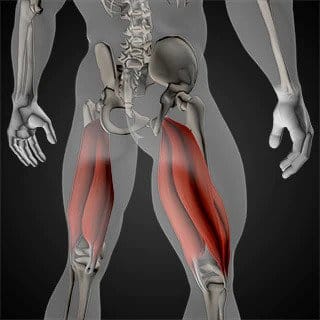
Quadriceps:
Located on the front side of the thigh, opposing the hamstrings, the quads are a group of four muscles: the rectus femoris, vastus medialis, vastus lateralis, and vastus intermedius.
Due to the elliptical having slightly higher ranges of motion at the hip and knee, the increased knee flexion provides excellent strength-training results for the quads.
As you push the pedal back, the quads contract to provide power during the pedal stroke. They then lengthen slightly on the upward phase as this is the eccentric portion of the movement. To challenge your quads even further, increase the resistance or reverse the motion.
Strengthening the quads will help with lower-body strength movements like squats, lunges, quad extensions, and split squats. It also helps with everything from cycling to tasks as simple as getting up from your chair or climbing stairs.
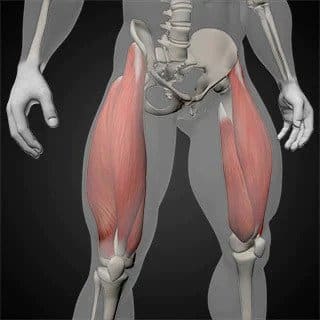
Calf Muscles:
Consisting of the gastrocnemius and soleus muscles on the back of your lower leg, the calf muscles work together with the tibialis anterior, found on the front of your shin, to contract and stabilize your legs throughout the elliptical motion.
As you press through the ball of your foot on the downward part of the pedal stroke, the calves perform plantar flexion to assist the quads. During these movements, you’re also strengthening your feet and ankles, both of which are essential for everything from supporting your weight to walking.
Strong calves can also help you avoid injuries, so don’t neglect your lower legs!
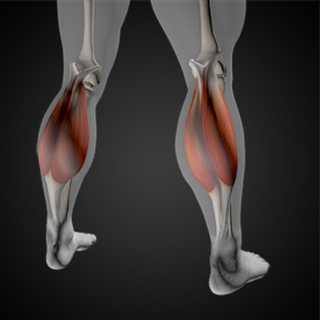
Upper Body Push Muscles
The upper body pushing muscles consist of the chest, anterior deltoid, serratus anterior, and triceps. Let’s see how the elliptical works these upper body muscles.
Chest:
The chest consists of the pec major and minor, but when discussing the muscles worked on elliptical machines, it’s the pec major primarily working. This is the large fan-shaped muscle located on the front of your upper body, which is primarily responsible for flexion, adduction, and internal rotation of your humerus.
When using the elliptical, each time you push the handle forward, you are activating your pec muscles. It will not have the same effect as a push-up or bench press, but it will help build endurance in your chest muscles.
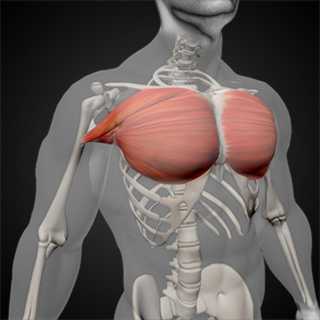
Anterior deltoid:
The deltoid is a three-headed muscle that sits on your shoulders. The active head when on the elliptical is the front head located on, you guessed it, the front of your shoulder.
This muscle assists the chest with shoulder flexion. This means that it activates each time you push the handle forward.
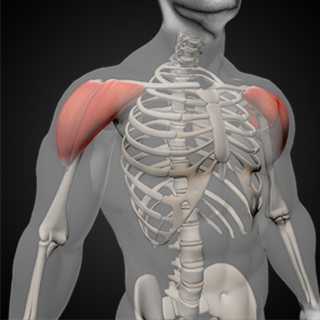
Serratus anterior:
The serratus anterior, also known as the boxer’s muscle, sits on the side of your chest and acts to pull the scapula around the thorax, which is the area between your neck and stomach.
This means that each time you push the elliptical handle forward, the serratus anterior is responsible for protracting your scapula.
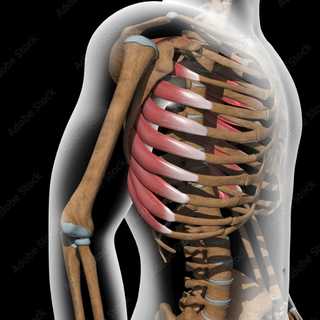
Triceps:
The triceps is a three-headed muscle located on the back of your arm. The long, medial, and lateral heads have different origins, but all attach to the same place on your elbow.
The triceps work concentrically as you push the handlebar away from you and extend your elbow.
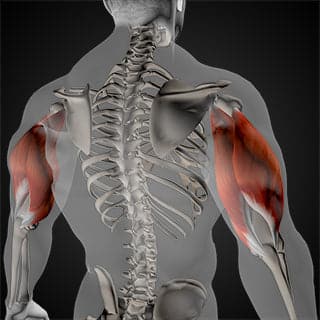
Upper Body Pull Muscles
The upper body pull muscles include the traps, rhomboids, lats, and biceps. Here’s an overview of how each is activated during an elliptical workout.
Trapezius:
Beginning at the base of your skull and continuing down to your lower thoracic spine, the traps are a large trapezoid-shaped muscle.
They work along with the rhomboids to make up the upper back. During the pulling portion of the elliptical motion, the traps work to retract and depress the scapula.
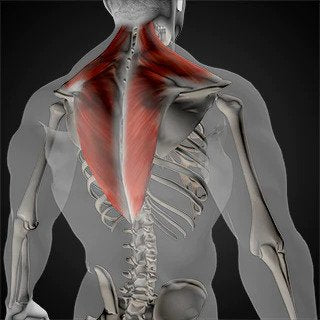
Rhomboids:
This rhombus-shaped muscle originates from your cervical vertebra, attaching to the inside of your shoulder blades. It is an important muscle, but as it’s beneath the traps, it’s hard to see.
During the elliptical pulling movement, the rhomboids retract the scapula, along with the traps and lats. Strengthening the rhomboids directly improves your posture and helps alleviate upper back pain.
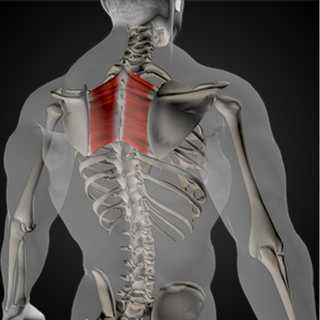
Latissimus dorsi:
The lats are the broadest muscle of the upper body, originating on your thoracic vertebrae, iliac crest, costal ribs, and scapula. They then insert into the humerus between the pec major and teres major.
Both during everyday movements and lats exercises, they are responsible for the internal rotation of the arm, extension, and adduction. During the pulling motion of the elliptical, they are a part of the system of muscles responsible for the scapula’s motion.
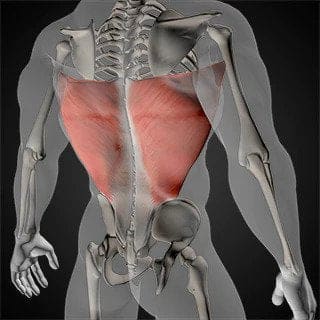
Biceps:
The bicep is a two-headed muscle on the front of your upper arm, originating on the scapula and inserting into the elbow.
The biceps flex the elbow and forearm while assisting the lats during the elliptical pulling motion.
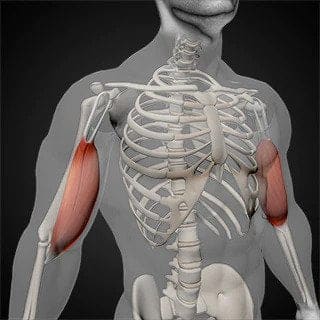
Core Muscles & Lower Back
We can’t forget about your core and lower back muscles that are activated during an elliptical workout! Here’s a look.
Erector spinae:
The erector spinae is a group of muscles that run from your hips to the base of your skull.
The iliocostalis, longissimus, and spinalis are responsible for straightening the back and working with the glutes to stabilize your posture.
Hip flexors:
This group of muscles consists of the iliacus, psoas, pectineus, sartorius, and rectus femoris.
They work to flex your hip as your leg comes forward and up during the elliptical stroke. Hip flexor strengthening exercises are important as they also work along with the quads to extend your knee.
Rectus Abdominis:
This is your favorite mirror muscle, the six-pack abs. These abdominal muscles run vertically up the front of your torso and are responsible for spinal flexion and anti-extension.
It keeps your body stable and upright while you are on the elliptical.
Obliques:
The obliques consist of two sets of muscles: the internal and external obliques.
The obliques are next to the rectus abdominis and run from your hips to your ribcage. They’re responsible for rotating and preventing the rotation of your torso.
Transverse Abdominis:
The deepest core muscle, the transverse abdominis acts as a corset and maintains abdominal tension.
Along with the rectus abdominis and obliques, these muscles work to isometrically keep your body stable and transfer power from the upper to the lower body, which helps protect and stabilize your spine.
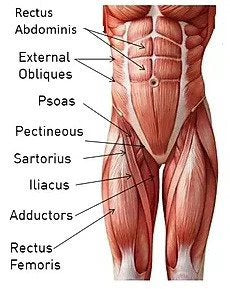
Does an Elliptical Build Muscle & Help With Weight Loss?
It won’t grow your chest like a bench press workout, but there is evidence that cardio, such as the elliptical, can build muscle2. Elliptical exercise, of course, should be in conjecture with enough of a calorie surplus to support muscle growth, correct macronutrient goals, and a proper workout split.
Although the elliptical machine is a full-body workout and uses the major muscle groups of the lower body, triceps, and upper back, you shouldn’t rely solely on the elliptical to build muscle. This activity is primarily for endurance training to improve your cardiovascular health.
Depending on the intensity, elliptical workouts use slow-twitch muscle fibers, which are meant for muscular endurance. And this makes it better for getting into the fat-burning zone, not muscle-building. Exercises that engage your fast-twitch muscle fibers, such as seen with resistance training and other high-intensity activities, are better for building muscle.
But the elliptical does play a role in building muscle. By improving your aerobic endurance, you can enhance your recovery between resistance training sessions and even between sets of strength training exercises. This sets the foundation for getting stronger, which can help you build muscle and improve muscular strength.
The elliptical is a great tool to add to your weight loss routine because of its ability to burn calories. Depending on your weight, the calorie burn can be up to 400 calories in 30 minutes on this machine. Check out our article on the best elliptical workouts for weight loss to get started!
That, of course, needs to be combined with a proper resistance training program and a diet that focuses on hitting appropriate macronutrients. Check out our article on counting macros if you’d like to learn more about it.
How to Use Elliptical Machines
Follow these step-by-step directions to get the most out of your elliptical workout.
- Step onto the elliptical and face the console. Generally, the machine stays off until you start to move.
- Grab the handles and push the pedals forward with your feet.
- As the screen turns on, follow the instructions on the display to select a pre-set workout program, or you can choose a manual/quick start session to set up your own workout.
- Increase or decrease the resistance as you work out by hitting the up and down arrows. You can also increase or decrease the incline on most ellipticals.
- Once you are finished, ensure the elliptical has stopped before getting off.
Benefits of an Elliptical Workout
Looking for a reason to start using the elliptical? We’ll give you more than one!
- Low Impact: The elliptical is a great LISS activity that is much gentler on your joints when compared to exercises like running. Not only does it help you rehab injuries, but it also helps prevent future overuse injuries.
- Works The Entire Body: Most cardio options work your leg muscles. But in addition to activating your legs, an elliptical is also an excellent option for upper body and core training.
- Easy To Use: The learning curve is small for using this machine. It is a great option for all fitness levels and most ages.
- You Can Progressively Make It Harder: An elliptical is an excellent option for steady-state cardio sessions, recovery sessions, or challenging HIIT sessions.
Looking for even more awesome perks of the elliptical? Check out our comprehensive article on the best elliptical benefits!
Programming the Elliptical
When planning your elliptical workouts for the week, it’s a great idea to shoot for 2-3 steady-state sessions around 30 minutes in length and 1-2 HIIT sessions. To continue improving and challenging yourself, we highly recommend becoming best friends with your elliptical’s resistance button and incline option.
When it comes to building muscle, challenge your muscles by increasing the resistance. If burning fat is your goal, utilize heart rate training to ensure your fat burning HIIT workout intervals are intense enough.
You’ll need to get your heart rate high enough during cardio exercise to burn as many calories as possible. It may take some trial and error to figure out what levels are right for you when you start, but you’ll catch on quickly.
The Best Muscle Building Elliptical Workout
Remember, you’re not going to build massive muscle using the elliptical. But it is going to help strengthen them by increasing their endurance and ability to recover.
You can also combine an elliptical cardio workout with actual strength training exercises to get the best of both worlds.
- Warm up on the elliptical for 5 minutes by going slowly.
- Increase the resistance as high as you can tolerate for 30 seconds. Recover at an easier pace for 30 seconds. Repeat 5 times.
- Hop off the elliptical and do 25 push-ups and 25 squats.
- Increase the incline to as high as you can tolerate for 1 minute. Recover at a more manageable pace for 1 minute. Repeat 3 times.
- Hop off the elliptical and do 25 push-ups and 25 lunges per leg.
- Choose a medium-level resistance or low incline, and go as fast as you can for 20 seconds. Recover for 20 seconds. Repeat 6 times.
- Cool down for 3-5 minutes at a leisurely pace.
The Best Weight Loss HIIT Workout
Looking for a HIIT workout to blast fat and torch calories? You’ve found it! Excluding the warm-up and cool down portions, the entire workout is 30 minutes.
- Warm up for 5 minutes.
- Alternate between 20 seconds of the highest resistance you can handle, and then lower it to a slower pace for 40 seconds of recovery. Repeat for 10 minutes.
- For the next 10 minutes, go as fast as you can for 20 seconds while on a challenging incline. Recover for 40 seconds at the same incline but at a slower pace.
- For the final 10 minutes, alternate between 30 seconds of backward motion as fast as you can, followed by 30 seconds forward at a more manageable pace for recovery.
- Cool down for 3-5 minutes.
The Elliptical Machine Can Help You Hit Your Workout Goals
You should now have a solid understanding of the muscles worked by the elliptical trainer, as well as how to effectively train for any goal, whether it’s to build muscle, lose weight or body fat, or simply increase your endurance.
Like any exercise, the elliptical is what you make it. If you challenge yourself with resistance, incline, and intervals, you’ll be well on your way to hitting all of your goals.
Interested in taking advantage of the elliptical’s many benefits from the comfort of your own home? Check out our articles on the best elliptical machines under $1000 and the best ellipticals for all budgets.

- Prosser LA, Stanley CJ, Norman TL, Park HS, Damiano DL. Comparison of elliptical training, stationary cycling, treadmill walking, and overground walking. Electromyographic patterns. Gait & Posture. 2011;33(2):244-250. doi:10.1016/j.gaitpost.2010.11.013
- Konopka AR, Harber MP. Skeletal Muscle Hypertrophy After Aerobic Exercise Training. Exercise and Sport Sciences Reviews. 2014;42(2):53-61. doi:10.1249/jes.0000000000000007



















